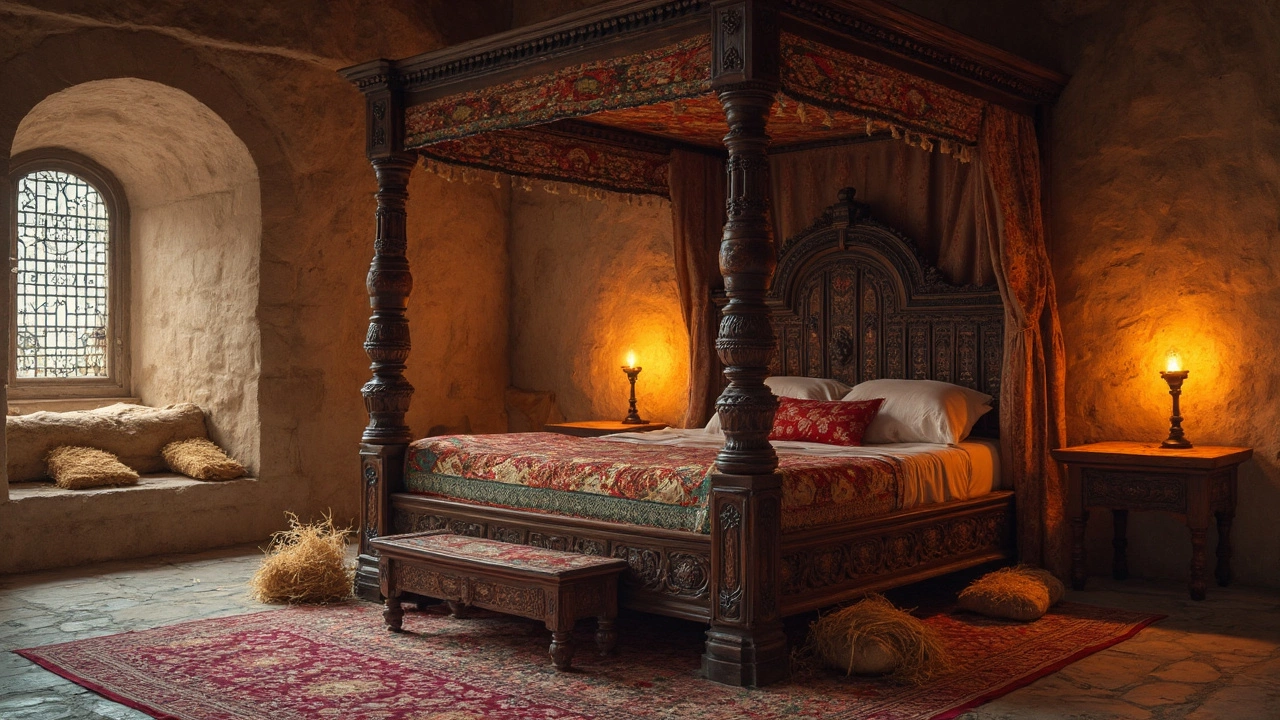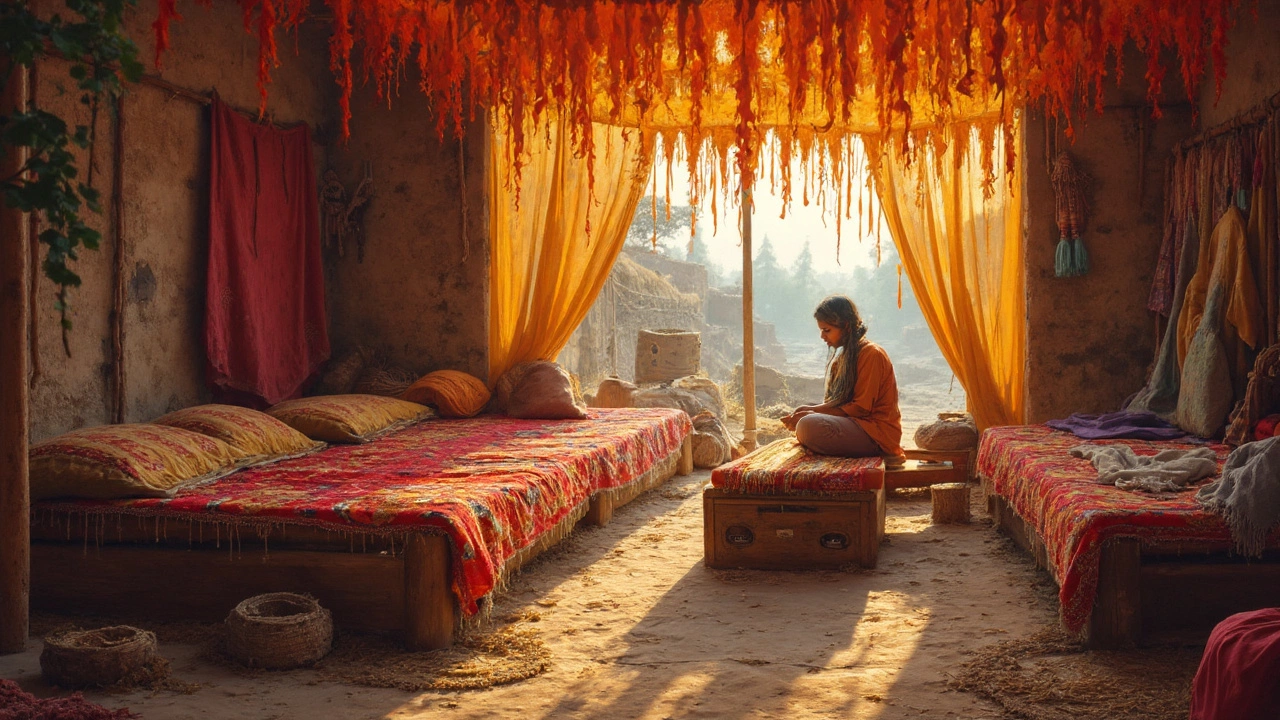Bedding in Medieval Times: How People Slept Back Then

Picture this: You're stepping into a medieval bedroom. What do you think you'd find? Forget the memory foam and plush pillows. Back then, folks were dealing with pretty different sleep setups!
First off, beds weren't just pieces of furniture. They symbolized status and wealth. Rich folks flaunted their fancy four-posters, complete with intricate carvings and luxurious fabrics. On the flip side, the everyday Joe might be happy with a simple straw-stuffed sack.
Materials used in medieval bedding ranged from the practical to the exotic. Straw or hay was a common stuffing material for mattresses, topped off with sheets made of wool, linen, or in posh households, silk. Imagine the scratchiness—a far cry from today's soft cotton sheets!
Types of Beds
In medieval times, beds came in all shapes and sizes. They said a lot about who you were and how much cash you had. If you were a noble, your bed was basically an extension of your power and prestige, while common folk kept things simple and practical.
Noble and Royal Beds
The elite slept on extravagant four-poster beds. These high-status medieval beds were often masterpieces, heavily carved and draped with rich fabrics like velvet and silk. You could draw the curtains for privacy or warmth. A contemporary account from Henry Beveridge explains:
"Beds were a symbol of wealth. The intricacy and material signify one's place in society."
Common Folk's Sleep Solutions
Meanwhile, the everyday person might have a straw mattress on a simple wooden frame or even on the floor. These were pretty basic—think wooden frames with a thin layer of hay or straw for comfort. Linen or coarse wool sheets kept them somewhat cozy.
Wondering how comfortable those straw-stuffed sacks were? It’s said they’d give you a decent sleep. Considering folks back then worked from dawn till dusk in the fields, they likely didn’t need cutting-edge comfort to get their shuteye.
Travel Beds and Alternatives
For those on the move, collapsible beds became popular. Travelers often carried a 'trundle bed'—a simpler version made to be portable. Imagine carting your sleeping gear from one medieval inn to another!
So there you have it, the lowdown on medieval beds. Whether you were royalty or a commoner, everyone had something to catch their forty winks on.
Materials Used
Back in the day, bedding in medieval times was all about making do with what you had, which was mostly natural materials. The kind of stuff you'd find around the house or in nature. This made medieval beds a mix of practical ingenuity and the little luxuries they could afford.
Keeping it Comfortable
Let's start with the basics—mattress stuffing. Straw was the go-to choice, mainly because it was cheap and easy to replace when it got grubby or flat. For those with a bit more cash, adding a layer of feathers could make all the difference, like having a primitive version of a featherbed. Think of it as the ancient Depop upgrade.
But it wasn't just about what's inside. The exterior was just as important. Linen sheets were standard, mostly because they were strong and breathable. Rich folks might splash out on silk or fine weaves. Can you imagine resting on expensive silk while others were chilling on what’s basically burlap?
Cozy Coverings
When it came to keeping warm—let's not forget those medieval castles weren't exactly toasty—wool was the way to go. It was bulky and warm, perfect for those drafty nights. And if you were lucky, you might layer it with colorful blankets or richly embroidered covers, flaunting a bit of visual flair.
Getting Fancy with Decor
Medieval bed decorations doubled up as status signals. Canopies, draperies, and bed curtains weren't just about aesthetics, though. We're talking functionality too—blocking out the cold or giving a little extra privacy. No one wants their snoring echoing through the whole keep.
As much as things were different, some things stay the same. Just like today, where you buy bedding based on looks, comfort, and budget, medieval folks were doing much the same, within the confines of their time.

Bedding Practices
So, how did they handle bedding practices in medieval times? It turns out there was quite a bit of thought put into the whole ordeal. Believe it or not, cleanliness was already a consideration, although not by today's standards. Beds were typically constructed to be off the ground, as much for status as for avoiding the dampness and dirt of medieval floors.
Makin' the Bed
You wouldn't find a well-springy mattress in a medieval home. Instead, home folks dealt with what they had—straw or hay mattresses, sometimes called 'paillasses'. These 'mattresses' were regularly aired out to prevent rot and creepy-crawlies. Linen sheets, woolen blankets, and occasionally silk covers for the wealthy topped off these sleeping arrangements.
Seasons Affecting Bedding
People of the time had to consider the drastically different seasonal temperatures. In winter, extra layers of fur and wool were added to retain warmth, while in summer, things were stripped down to avoid heavy, sticky nights.
Who's Sleeping With Who?
The concept of a 'bedroom' was pretty fluid. Often, entire families shared the same sleeping space. Privacy was a luxury few could afford. In noble homes, shared beds among servants or siblings were common, too, reflecting an era less sensitive to personal space.
If you've ever grumbled about making your bed in modern times, just think—it's all relative. At least you're not wrestling with straw!
Sleeping Arrangements
So, how did folks handle their sleeping arrangements back in the medieval days? Well, it wasn’t quite as private as you might be used to. Households, especially in the poorer classes, often shared beds because space and warmth were precious commodities.
For the wealthy, separate chambers were more common, but even they weren't immune to sharing when it came to family and guests. Privacy wasn't really a thing until much later, so don’t be too shocked if someone crashed your bed space!
Sharing the Bed
Many families cozied up in the same bed, often with children and sometimes even a visiting relative or two. Imagine climbing into bed with Mom, Dad, a couple of siblings, and maybe Aunt Susie visiting from down the road. Talk about cozy!
The Great Hall
In large households or castles, communal sleeping might happen in a big room called the Great Hall. Servants and household members would lay straw mattresses or pallets on the floor. It was the medieval dorm room: practical but far from comfy.
Seasonal Changes
Sleeping arrangements also changed with the seasons. In winter, keeping warm was challenging, so people often bedded down together for warmth. By contrast, in summer, sometimes lighter, portable beds were taken outside for a cooler night’s rest.
The way people managed their medieval sleep habits was a mix of practicality, resourcefulness, and a lack of modern amenities. So next time your bed feels too crowded, just be grateful you're not crammed in with the entire family!